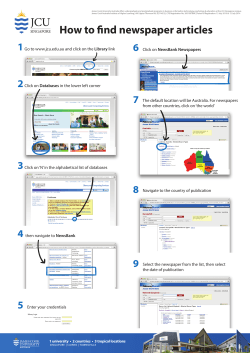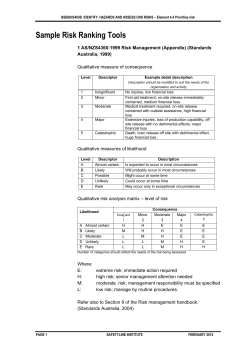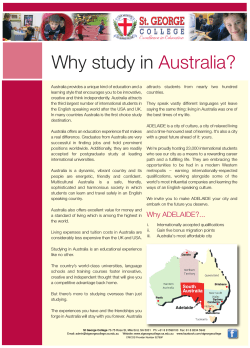
Article ZOOTAXA
Zootaxa 3873 (1): 049–061 www.mapress.com /zootaxa / Copyright © 2014 Magnolia Press Article ISSN 1175-5326 (print edition) ZOOTAXA ISSN 1175-5334 (online edition) http://dx.doi.org/10.11646/zootaxa.3873.1.4 http://zoobank.org/urn:lsid:zoobank.org:pub:88CD6B92-3C10-497C-BCEB-10BD46BD823C A new species of Velvet Gecko (Oedura: Diplodactylidae) from the limestone ranges of the southern Kimberley, Western Australia PAUL M. OLIVER1,3, REBECCA J. LAVER1, JANE MELVILLE1 & PAUL DOUGHTY2 1 Department of Zoology, University of Melbourne, Parkville, VIC 3052, Australia Museum Victoria, GPO Box 666, Melbourne, Victoria 3001, Australia. E-mail: Paul.oliver@anu.edu.au 2 Department of Terrestrial Zoology, Western Australian Museum, 49 Kew St, Welshpool, Western Australia 6016, Australia 3 Corresponding author Abstract We describe a new species of large Oedura from the Oscar Range on the southern edge of the Kimberley Craton in northwestern Australia. Oedura murrumanu sp. nov. can be distinguished from all congeners by the combination of large size (snout-vent length to 103 mm), moderately long and slightly swollen tail, tiny scales on the dorsum, fringe of laterally expanded lamellae on each digit, and 6–7 paired distal subdigital lamellae on the fourth toe. The new species is the first endemic vertebrate known from the limestone ranges of the southern Kimberley; however, this area remains poorly surveyed and further research (particularly wet season surveys and genetic analyses) is required to better characterise regional biodiversity values. Key words: Australian Monsoonal Tropics, endemism, lizard, mesic refigia, Oscar Range, saxacoline Introduction The Kimberley region of north-west Australia is characterised geologically by an array of ancient and highly weathered exposed rock formations (Tyler et al. 2012; Pepper & Keogh 2014). One distinctive and discrete geological feature of this region is a fringe of exposed fossilized Devonian limestone reefs that form a broken chain around much of the southern and eastern edge of the Kimberley Craton (Tyler 2011; Tyler et al. 2012). In the southwest Kimberley the exposed portion of these limestone deposits form the Oscar and Napier Ranges. These low (<100 m above the surrounding plains) and narrow ranges (generally less than a few km wide) are isolated from other ranges of exposed rock in the Kimberley by flat low-lying plains. While they are home to a diverse radiation of micro-endemic Camaenid snails (Solem 1985; Cameron 1992), no endemic vertebrates are currently recognised from this area. Australian Velvet Geckos (genus Oedura) are moderate to large geckos (snout-vent length [SVL] 69–113 mm) with a continuous distribution spanning much of northern and eastern Australia, with further isolates in the arid zone (Pilbara, Central Ranges and Flinders Ranges) (Oliver et al. 2012a, 2014; Wilson & Swan 2013). Two endemic species of Oedura are currently recognized from the Kimberley region: O. gracilis King, 1984 and O. filicipoda King, 1984. The former occurs over most of the Kimberley plateau and extends into the far north-west Northern Territory, while the latter is restricted to the deeply dissected sandstone plateaus of the relatively high rainfall zone of the north-west Kimberley (from the Mitchell Plateau in the north to the Artesian Range to the south; Fig. 1) (Atlas of Living Australia 2013). For nearly a decade, an additional distinctive Oedura has been known from the Oscar Range of the south-west Kimberley (G. Gaikhorst, M. Kearney, B. Stewart, pers. comm.), however, no specimens have been available for taxonomic study. During recent fieldwork in the south-west Kimberley we were able to collect a small series of this form to assess if it is distinctive from other recognised Oedura, especially O. filicipoda which it resembles. We found the Oscar Range form to be morphologically and genetically distinctive from all other Oedura Accepted by A. Bauer: 9 Sept. 2014; published: 14 Oct. 2014 Licensed under a Creative Commons Attribution License http://creativecommons.org/licenses/by/3.0 49 Acknowledgements We thank Clive Aiken and the Bunuba Rangers for their permission and co-operation in helping us to undertake research on the traditional lands of the Bunuba people. June Oscar and Diane Chungol kindly provided advice on the correct use and spelling of Bunuba words. We also thank Tracy Sonneman (Western Australia Department of Parks & Wildlife, Broome) for extensive advice, logistical support, and help with permits, Paul Horner and Susan Perkins for providing photographs and support in the field, and Glen Gaikhorst, Michael Kearney, Bill Stewart, and Corrin Everitt for bringing this taxon to our attention and for sharing their observations. Specimens were collected and preserved under Western Australian permit number SF009528. This work was supported by grants from the Australian Research Council to Paul Oliver, Michael Lee, and Paul Doughty, a Melbourne University Collaboration grant to Jane Melville and Paul Oliver, and a Mckenzie Postdoctoral fellowship to Paul Oliver from Melbourne University. References Atlas of Living Australia (2014) Website. Available from: http://www.ala.org.au (accessed 4 December 2013) Bowman, D.M.J.S., Brown, G.K., Braby, M.F., Brown, J.R., Cook, L.G., Crisp, M.D., Ford, F., Haberle, S., Hughes, J., Isagi, Y., Joseph, L., McBride, J., Nelson, G. & Ladiges, P.Y. (2010) Biogeography of the Australian monsoon tropics. Journal of Biogeography, 37, 201–216. http://dx.doi.org/10.1111/j.1365-2699.2009.02210.x Burbidge, A.A. & McKenzie, N.L. (1978) The islands of the north-west Kimberley, Western Australia. Wildlife Research Bulletin, 7, 1–47. [Department of Fisheries and Wildlife, Perth] Cameron, R.A.D. (1992) Land snail faunas of the Napier and Oscar Ranges, Western Australia; diversity, distribution and speciation. Biological Journal of the Linnean Society, 45, 271–286. http://dx.doi.org/10.1111/j.1095-8312.1992.tb00644.x Catullo, R., Lanfear, R., Doughty, P. & Keogh, J.S. (2014) The biogeographical boundaries of northern Australia: evidence from ecological niche models and a multi-locus phylogeny of Toadlets (Uperoleia: Myobatrachidae). Journal of Biogeography, 41, 659–672. http://dx.doi.org/10.1111/jbi.12230 Cracraft, J. (1991) Patterns of diversification within continental biotas: hierarchical congruence among the areas of endemism of Australian vertebrates. Australian Systematic Botany, 4, 211–227. http://dx.doi.org/10.1071/sb9910211 Doughty, P., Palmer, R., Cowan, M. & Pearson, D.J. (2012) Biogeography of frogs of the Kimberley islands, Western Australia. Records of the Western Australian Museum, Supplement 81, 109–124. King, M. (1984) Three new species of Oedura from the Mitchell Plateau of North Western Australia. Amphibia-Reptila, 5, 329–337. Macey, J.R., Larson, A., Ananjeva, N.B., Fang, Z. & Papenfuss, T.J. (1997) Two novel gene orders and the role of light-strand replication in rearrangement of the vertebrate mitochondrial genome. Molecular Biology and Evolution, 14, 91–104. http://dx.doi.org/10.1093/oxfordjournals.molbev.a025706 Miles, J.M. & Burbidge, A.A. (1975) A biological survey of the Prince Regent River reserve, north-west Kimberley, Western Australia. Wildlife Research Bulletin, 3, 1–113. [Department of Fisheries and Wildlife, Perth] Oliver, P.M., Adams, M. & Doughty, P. (2010) Extreme underestimation of evolutionary diversity within a nominal Australian gecko species (Crenadactylus ocellatus). BMC Evolutionary Biology, 10, 386. Oliver, P.M., Bauer, A.M., Greenbaum, E., Jackman, T. & Hobbie, T. (2012a) Molecular phylogenetic evidence for the paraphyly of the arboreal Australian gecko genus Oedura Gray 1842 (Gekkota: Diplodactylidae): yet another plesiomorphic grade? Molecular Phylogenetics and Evolution, 63, 255–264. Oliver, P.M., Hugall, A., Adams, M., Hutchinson, M. & Cooper, S. (2007) Genetic elucidation of ancient and cryptic diversity in a clade of Australian lizards: the Diplodactylus vittatus complex. Molecular Phylogenetics and Evolution, 44, 77–88. Oliver, P.M., Palmer, R. & Doughty, P. (2012b) Hidden biodiversity in northern Australia, the case of the Kimberley clawless geckos (Crenadactylus). Wildlife Research, 39, 429–435. Oliver, P.M., Smith, K.L., Laver, R.L., Doughty, P. & Adams, M. (2014) Contrasting patterns of persistence and diversification in vicars of a widespread Australian lizard lineage (the Oedura marmorata complex). Journal of Biogeography. http://dx.doi.org/10.1111/jbi.12364 Palmer, R., Pearson, D.J., Cowan, M.A. & Doughty, P. (2013) Islands and scales: a biogeographic survey of reptiles on Kimberley islands, Western Australia. Records of the Western Australian Museum, Supplement 81, 183–204. Pepper, M. & Keogh, J.S. (2014) Biogeography of the Kimberley, Western Australia: a review of landscape evolution and biotic response in an ancient refugium. Journal of Biogeography, 41, 1–13. Potter, S., Eldridge, M.D.B., Taggart, D.A. & Cooper, S.J.B. (2012) Multiple biogeographic barriers identified across the monsoon tropics of northern Australia: phylogeographic analysis of the brachyotis group of rock-wallabies. Molecular Ecology, 21, 2254–2269. 60 · Zootaxa 3873 (1) © 2014 Magnolia Press OLIVER ET AL. http://dx.doi.org/10.1111/j.1365-294x.2012.05523.x Powney, G.D., Grenyer, R., Orme, C.D.L., Owens, I.P.F. & Meiri, S. (2010) Hot, dry and different: Australian lizard richness is unlike that of mammals, amphibians and birds. Global Ecology and Biogeography, 19, 386–396. http://dx.doi.org/10.1111/j.1466-8238.2009.00521.x Slatyer, C., Rosauer, D. & Lemckert, F. (2007) An assessment of endemism and species richness patterns in the Australian Anura. Journal of Biogeography, 34, 583–596. http://dx.doi.org/10.1111/j.1365-2699.2006.01647.x Read, K., Keogh, J.S.K., Scott, I.A.W., Roberts, J.D. & Doughty, P. (2001) Molecular phylogeny of the Australian frog genera Crinia, Geocrinia and allied taxa (Anura: Myobatrachidae). Molecular Phylogenetics and Evolution, 21, 294–308. http://dx.doi.org/10.1006/mpev.2001.1014 Solem, A. (1985) Simultaneous character convergence and divergence of Western Australian land snails. Biological Journal of the Linnean Society, 24, 143–163. http://dx.doi.org/10.1111/j.1095-8312.1985.tb00166.x Tamura, K., Peterson, D., Peterson, N., Stecher, G., Nei, M. & Kumar, S. (2011) MEGA5: Molecular Evolutionary Genetics Analysis using Maximum Likelihood, Evolutionary Distance, and Maximum Parsimony Methods. Molecular Biology and Evolution, 28, 2731–2739. http://dx.doi.org/10.1093/molbev/msr121 Tyler, I. (2011) Geology and Landforms of the Kimberley. Department of Environment and Conservation, Western Australia, Perth, 72 pp. Tyler, I.M., Hocking, R.M. & Haines, P.W. (2012) Geological evolution of the Kimberley region of Western Australia. Episodes, 35, 298–306. Wilson, S. & Swan, G. (2013) A Complete Guide to Reptiles of Australia. 4th Edition. New Holland Publishers, Sydney, 592 pp. APPENDIX 1. Comparative material examined. Oedura filicipoda (n = 7). Western Australia. WAM R60685, WAM R83707–8 (holotype and paratypes)—Camp Creek, Mitchell Plateau (14.83°S, 125.83); WAM R86897—11 km SE Mount Daglish (16.38°S, 124.98°E); WAM R167805—Surveyor’s Pool (14.67°S, 125.73°E); WAM R138874—4.1 km S Donkin’s Hill (14.99°S, 125.51°E); WAM R171552—Prince Regent Nature Reserve (15.76°S, 125.26°E). Oedura gracilis (n = 52). Western Australia. WAM R108641—10 km SE Warmun (17.12°S, 128.25°E); WAM R100186—2.5 km N Face Point, Carson Escarpment (14.84°S, 126.82°E); WAM R138891—4.1 km S Donkin’s Hill (14.99°S, 125.51°E); WAM R138878—4.1 km S Donkin’s Hill (15.00°S, 125.50°E); WAM R168565–6—Augustus Island (15.35°S, 124.53°E); WAM R171204—Augustus Island (15.39°S, 124.59°E); WAM R171205—Augustus Island (15.35°S, 124.53°E); WAM R168903–4—Bigge Island (14.60°S, 125.12°E); WAM R168564—Boongaree Island (15.10°S, 125.20°E); WAM R103127—Purnululu National Park (17.43°S, 128.40°E); WAM R166107–8—Doongan Station (15.38°S, 126.30°E); WAM R172903–4—Doongan Station (15.20°S, 125.90°E); WAM R172865–71—Ellenbrae Station (15.98°S, 127.05°E); WAM R164908–10—Kater's Island (14.46°S, 125.52°E); WAM R168739—Kater’s Island (14.47°S, 125.53°E); WAM R171751—King Edward River (14.89°S, 126.20°E); WAM R114396—Koolan Island (16.15°S, 123.75°E); WAM R171670—Lachlan Island (16.62°S, 123.47°E); WAM R171671–3—Long Island (16.56°S, 123.36°E); WAM R106213—Manning Gorge (16.67°S, 125.95°E); WAM R151005—Mount Nyulasy (16.75°S, 128.29°E); WAM R171677—NW Molema Island (16.26°S, 123.82°E); WAM R156728—Oscar Range (17.64°S, 125.17°E); WAM R168057—Prince Regent River Nature Reserve (15.75°S, 125.37°E); WAM R152718—Purnululu National Park (17.39°S, 128.26°E); WAM R156724–5—Purnululu National Park (17.40°S, 128.41°E); WAM R168454, WAM R168463—Sir Graham Moore Island (13.88°S, 126.57°E); WAM R151963, WAM R151980—South West Osborn Island (14.35°S, 125.95°E; WAM R164863–4—South West Osborn Island (14.37°S, 125.94°E); WAM R171668–9, WAM R171675—Storr Island (15.95°S, 124.56°E); WAM R171674—Sunday Island (16.43°S, 123.18°E); WAM R172341—Theda Station (14.81°S, 126.51°E). Oedura marmorata (n = 31). Western Australia. WAM R165150—1.5 km NNW Python Pool (21.32°S, 117.23°E); WAM R129595, WAM R129622—120 km NW Newman (22.92°S, 118.88°E); WAM R129635—120KM NW Newman (22.92°S, 119.02°E); WAM R52852—12 km E Tallering Peak (28.10°S, 115.75°E); WAM R84365–6—17 km NNE Anketell Homestead (27.90°S, 118.95°E); WAM R87544—30KM SSW Glenburgh homestead (24.68°S, 115.00°E); WAM R160074—32.5 km ESE Meentheena Outcamp (21.33°S, 120.75°E); WAM R146593–4—40 km SE Pouyouwuncubban (22.15°S, 119.02°E); WAM R160066—58 km ESE Meentheema Outcamp (21.32°S, 121.00°E); WAM R84004—6 km N Mount Magnet (28.03°S, 117.85°E); WAM R105965, WAM R106289—7 km N Mount Magnet (28.00°S, 117.88°E); WAM R132626—Burrup Peninsula (20.60°S, 116.81°E); WAM R119991—Hope Downs (23.01°S, 119.10); WAM R119993—Hope Downs (23.00°S, 119.12°E); WAM R135369, WAM R135445—Mt Brockman (22.31°S, 117.32°E); WAM R154783—Mt Brockman (23.31°S, 119.89°E); WAM R157504, WAM R157508, WAM R157516—Packsaddle Range (22.92°S, 118.89°E); WAM R132296—Ulongunna Rock (27.12°S, 117.23°E); WAM R119086—Virgin Springs, Carnarvon Range (25.10°S, 120.72°E); WAM R154796—Walga Rock (27.40°S, 117.47°E); WAM R154797—Walga Rock (27.40°S, 117.47°E); WAM R157595—West Angelas (23.19°S, 118.86°E); WAM R97012—Woolgerong Rock (27.40°S, 117.38°E); WAM R119837—Yandicoogina (22.72°S, 119.02°E). A NEW OEDURA FROM NORTH-WESTERN AUSTRALIA Zootaxa 3873 (1) © 2014 Magnolia Press · 61
© Copyright 2025









